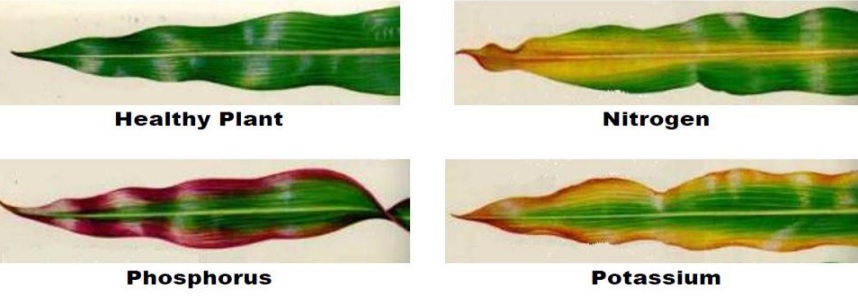19 PLANT NUTRIENTS FOR IMPROVING AND PROTECTING PLANT HEALTH
19 PLANT NUTRIENTS FOR IMPROVING AND PROTECTING PLANT HEALTH
Plants use minerals present in the soil and water in order to grow and flourish. Just like with humans, if they don’t get enough of these nutrients it can seriously affect their health. Ensuring proper plant nutrition by using fertilizers (organic and mineral) to supplement the nutrients already available in the soil is essential for plant health. The table below lists the nutrients, their status as macro- or micronutrients, their uptake forms, and their plant mobility.

Table 1. The status, uptake forms, and mobility of nutrients
Here’s a look at 19 nutrients that can benefit plant health (in addition to improving yields):
Primary Macronutrients
The primary nutrients include nitrogen (N), phosphorus (P), and potassium (K). These elements contribute to plant nutrient content, function of plant enzymes and biochemical processes, and integrity of plant cells. Deficiency of these nutrients contributes to reduced plant growth, health, and yield.
🌱 Nitrogen is an essential component of amino acids for building proteins, nucleic acids and chlorophyll which converts the sun’s energy into sugars. It is vital for plant metabolism, growth and health.
🌱 Phosphorus is vital for energy storage and transfer and membrane integrity in plants. Particularly important in early growth stages, it promotes tillering, root development, early flowering and ripening.
🌱 Potassium has major functions in enzyme activation, transpiration and the transport of assimilates (the products of photosynthesis). It helps plants to retain water during droughts, provides strength to plant cell walls and decreases susceptibility to diseases and insects.

Secondary Macronutrients
Calcium, magnesium, and sulfur are essential plant nutrients. They are called “secondary” nutrients because plants require them in smaller quantities than nitrogen, phosphorus, and potassium. On the other hand, plants require these nutrients in larger quantities than the “micronutrients” such as boron and molybdenum.
🌱 Calcium is needed for biomembrane maintenance. It helps in cell wall stabilization as an enzyme activator, in osmoregulation and in the cation-anion balance and thus also plays important roles in resistance to diseases and abiotic stresses such as drought, heat and cold.
🌱 Magnesium is central to the production of chlorophyll which is needed for photosynthesis and healthy green leaf tissue. It reduces crop stress caused by exposure to the sun and high temperatures, while a deficit can often cause stunted growth.
🌱 Sulfur is integral to all living plant cells and helps to produce amino acids involved in chlorophyll production, proteins and vitamins. It contributes to plant growth and seed formation, improves winter hardiness and helps plants resist diseases.

Table 2. Average percentage of chemical content of major sources of calcium, magnesium, and sulfur.
Micronutrients
Micronutrients are used by plants in small amounts, less than 1 part per million. Minor elements are difficult to analyze accurately with soil tests. Plant tissue analyses are more reliable for determining whether or not plants are getting sufficient quantities of minor elements. Of the minor elements, boron (B) and zinc (Zn) are the most likely to be needed to supplement soil levels.
🌱 Iron is another essential component for creating chlorophyll and also serves as a catalyst for cell division which is central to plant growth. Many plants also use iron for their enzyme functions. A lack of iron results in yellowing leaves and poor fruit quality and quantity.
🌱 Copper plays a key role in nitrogen and hormone metabolism and is needed for many enzyme activities in plants, as well as for chlorophyll and seed production. Deficiencies can lead to crop failure and increased susceptibility to diseases such as ergot.
🌱 Zinc participates in chlorophyll formation, is needed to activate many enzymes in plants and is needed for plant immune responses. As a result, it is important for increasing plant resistance to diseases and pests.
🌱 Boron is required for cell wall synthesis and cell expansion. Boron deficiency disrupts reproductive growth, shoot and root growth and pollen viability and hence influences seed set and yield. A lack of boron can result in deformed leaves and poor quality of harvested product.
🌱 Manganese plays a key role in a variety of plant functions including photosynthesis, enzyme activation, respiration and nitrogen assimilation. Deficiencies can cause weaker structural resistance against pathogens and less tolerance to drought and heat stress.
🌱 Molybdenum is used by plants to reduce nitrates into usable forms and for biological nitrogen fixation by certain species. Insufficient molybdenum means some plants can’t fix nitrogen from the air to make proteins and can hinder normal plant growth.
🌱 Chlorine improves plant productivity, plays a role in photosynthesis and is needed for osmosis and ionic balance. It can help to minimize water loss during stressful dry periods and enhance disease resistance.
🌱 Selenium is chemically similar to sulfur and it is taken up inside plants via sulfur transporters inside the roots. Studies show that selenium improves plant growth and increases tolerance to biotic and abiotic stresses.
🌱 Silicon increases plant vigor and improves tolerance to abiotic stresses such as drought, salinity or heavy metals. It enhances plant cell walls’ strength and structure, increasing resistance to plant diseases and insect pests. Good silicon nutrition stimulates photosynthesis and improves grain production.
🌱 Sodium is essential in transporting CO2 during photosynthesis for a limited number of plants. For other plant species, because it is chemically and structurally very similar to potassium, it can also fulfill many of the roles played by potassium, including metabolic ones.
🌱 Cobalt is an essential component of some enzymes and co-enzymes that can affect the growth and metabolism of plants. It is also necessary for nitrogen (N) fixation which occurs within the nodules of legumes. Cobalt can increase seeds’ drought tolerance and reduce plant stress.
🌱 Nickel is important in plant seed germination, photosynthesis, enzyme functions and nitrogen metabolism. A deficiency affects plant growth, antioxidant systems and response to stress.
🌱 Iodine has been found to be associated with enzymes in plants. Research suggests that it is important for biological processes such as photosynthesis, energy metabolism and calcium-signaling. Iodine deficiency delays flowering and disrupts root, leaf and fruit development as well as plants’ environmental and climatic stress defenses.
Contact your sales representative to formulize accurate nutrients mix tailored to your soil, climate, and crop type.
REFERENCE
International Fertilizer Association, 28 May 2020.
Oldham L., 2019, Secondary Plant Nutrients: Calcium, Magnesium, and Sulfur, Mississippi State University Information Sheet 1039 (POD-07-19).
University of Massachusetts, UMass Extension Fruit Program, Plant Nutrients—major & minor.
